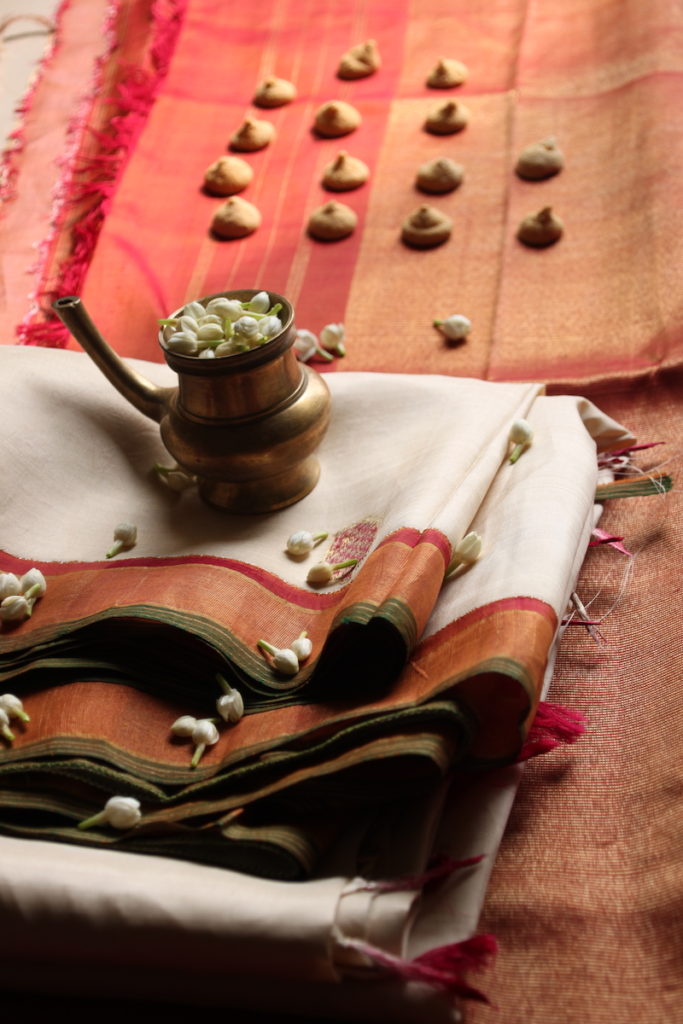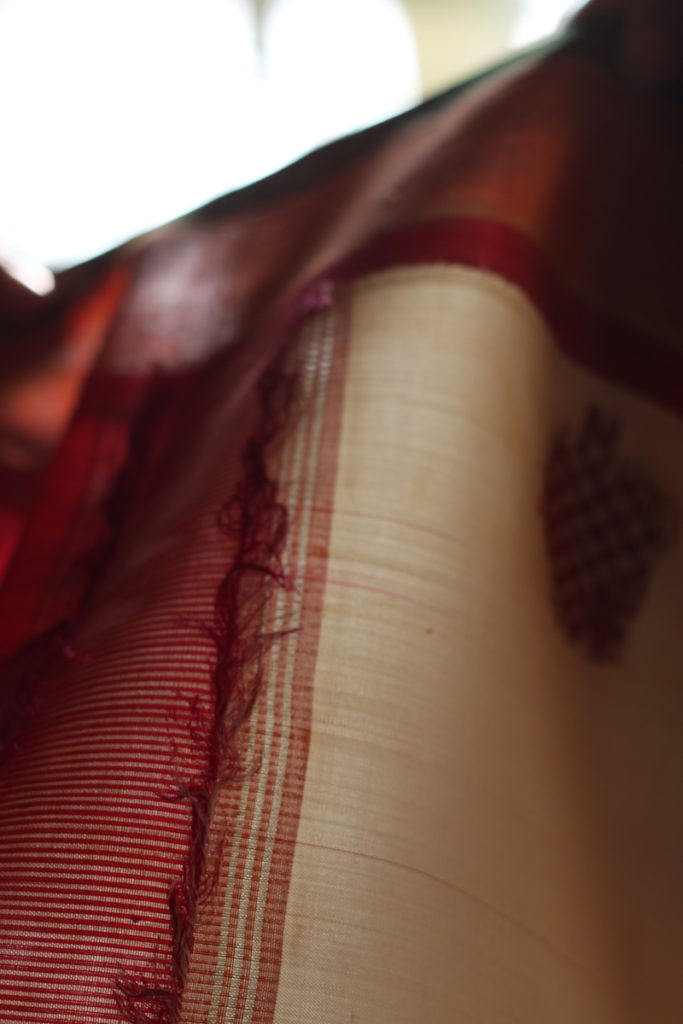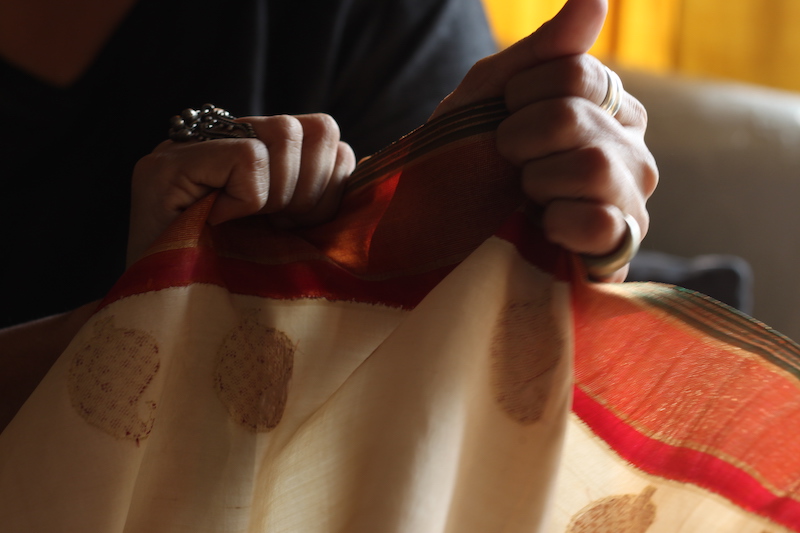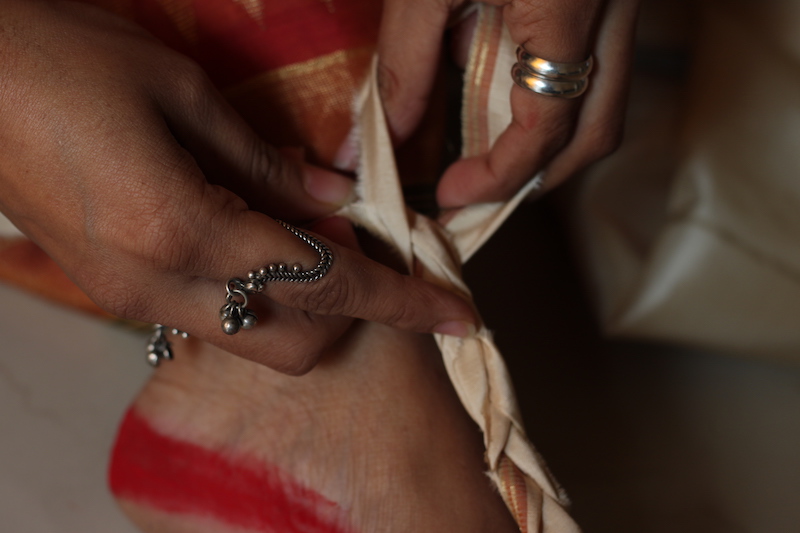Published 25 August 2019 ● Last Updated on 17 July 2020
In part 2 of the Sari Strategy series, guest author Sathya Bhavana, the founder of ‘Re’vastra articulates how she plans all the Sari repurposing she does with the ultimate objective to create no waste! As she rightly says, her design strategy is ‘preventive’ not ‘curative’ so as to render it circular.
Namaskaram!
In my previous story, one of the aspects I discussed was the ‘Recycling’ of a sari. It loosely ideated ways of shaping (read: repurposing) it into a set of garments, which was about a simple play of the 5.5-meter textile into zerowaste designs. This helped me be in awareness of the fabric. And eventually avoid annihilating (although unknowingly) some history, narrative, emotion with handwork that the drape’s cellular memory had collected since its ‘birth’. However, before I put this method to use, I was clueless about or ignored the sari scrap (waste) that my traditional methods of repurposing generated. So, here are a few steps that I followed (was mindful of) before I started repurposing. Because one way to build a circular economy in repurposing fashion could be designing to ‘prevent’ not ‘cure’ sari waste. NOTE: These steps are not hard and fast. Just enjoy the creative process. You can modulate them as per your real-time geography, sensibility, time, do-ability, budget and method choice. And choose one of these methods to actualise your design.
- Working on handcrafting the sari yourself.
- Locating a local or Indian tailor who could follow your instructions.
- Zeroing on an haute couture designer who you admire in Singapore or India.
STEP 1: Listened to the sari and its stories.
First, I began by asking questions about the sari’s stories. I cross-questioned myself, my mom, grandmom, mother-in-law, aunt or whoever wore it with or before me. I let my heart speak what it felt when I saw that sari that I wanted to repurpose. Then I goaded others to tell me tales of the sari’s travels and memories—both joyful and sorrowful. There were so emotive and varied. I actually made mental, physical and virtual notes!
Result: A short but nostalgic narrative.

STEP 2: Studied the sari’s design and symbolism.
Next, I made an effort to understand its visual and spatial design. I felt the fabric, learnt its hand or machine loom origin, its nativity (which part of India it was from), iconography, cultural context, blend (percentile of mix—say, cotton-silk, viscose-silk, and the like), weave structure (jacquard, plain, ikat), and any decoration (print, dye, artwork, craft or other surface ornamentation). I learnt that historically, a sari is derived from a three-piece Vedic ensemble — Antriya or lower garment; Uttariya or covering worn over shoulders; and Stanapatta or chest band. I also discovered that earlier the weaver’s class (varna), status and later other demographics like community, his or her life, surroundings, and things were symbolically woven into these textiles. With time, each sari became a symbol of a community and its geography, and was infused with fascinating stories. For instance, here are two shapes I find endearing:
- Temple motif (called kumbho in Odiya; kumbham in Telugu; daanth in Bengali); or mottu/mokku in Tamil).: Triangle or step shape seen in the drapes of Odisha, Andhra, Bengal, and Tamil Nadu. Interestingly, temple here does not mean a temple, but implies fertility, flowers, or teeth!
- Checks (called charkhana or chand-tara in Hindi); valai in Tamil); vala in Telugu): Seen in the drapes of South India and other regions. For instance, the basic and bright Patteda Anchu is a reversible, handloom cotton sari with tiny checks from North Karnataka. It was an offering to a Devadasi during a daughter’s marriage. Another example is the medium-checked and striped Koorai Pattu Pudavai (Korainadoo sari) from Tamil Nadu. This is a ‘temple sari’ historically offered to a local deity.
Result: A textile-based, mini research of sorts.

STEP 3: Checked the sari’s shape and size.
Then I gave the sari’s rudimentary shape — a rectangle — some thought. Almost always contemporary ones measured anywhere between five to nine yards (4.5 metres to 8 metres) in length and two to four feet (60 centimetres to 1.20 metres) in breadth. Sometimes more, sometimes less (think Maharashtrian Navari or nine-yard or Santhal or Gondh tribal wraps). According to Linda Lynton in her book ‘The Sari’ (Thames & Hudson), saris come in a variety of sizes (Table of Measurements; p.199) depending on its region, use and type. Each comprises of blocks. Commonly, first is the entire base fabric or body (a.k.a. field), then is the set of top and bottom longitudinal borders, followed by the decorated (front) endpiece (‘pallu’ in Hindi) and finally the inner endpiece—that denotes the finish of the weave. Once I knew this aspect of the drape, I could now design or get it designed based on the fabric that was available to me.
Result: Design thinking that helped retain both the nostalgia and the fabric.

STEP 4 Measured the sari’s length and width.
I also measured the size of the fabric. Using my fingers, palms, arms and even my body, I mapped the sari. Like width of each linear border is about four fingers wide or more. Length of the sari is a few single arms long. Width of the sari is a little beyond both my shoulders. Till I researched, I did not realise that I was using age-old measurement techniques! Traditionally, body and its parts were THE tools. The ever-famous book Saris of India—compiled and edited by sari expert Rta Kapur Chishti and edited by Martand Singh, describes regional variations rather beautifully. According to it, most native sari-wearers and sellers from States of India use various words in their dialects to denote these anatomy-related sizes. Then was the sari folding and storing. I usually hung my saris on hangers or flat-folded them. If the sari stayed untouched for long, the crease lines showed. Sigh. But traditionally, weave lines were used as markers to fold the saris. The saris were then halved, quartered and sometimes rolled, too. The repeats, patterns and designs on the sari were always tucked in carefully. I followed these mechanics and they made me understand my sari better.
Result: Heightened awareness of the sari to find reusable sections, faults or tears.

STEP 5: Re-loved Indian aesthetic and elements.
I read up on Indian art and craft a tad more than before. A lot of surface ornamentation was cultural craft or art of a region. The materials, colours, textures and design principles were extensions of the region. I learnt that artisans are almost always more aware of recycling and repurposing saris than what we are! Most play with the geometricity pretty well. Maximising the fabric is always their motive.
- West Bengal’s Kantha embroidery: Sari in its totality is folded, layered and covered with micro running stiches. Sometimes older saris are sandwiched or patchworked to create the required design.
- Odisha’s Pipli applique: Sari scrap is used to fill in gaps in design. Sometimes sari motifs (butis) are outline-cut precisely and hand-appliqued on to bright poplin fabrics. These deigns go on utility items like bags, umbrellas, mats and the like.
- Gujarat’s Waghri community: Saris are cut up into pieces according to their basic shape of border designs, motifs and decorative ends. The pieces are then backed with a thicker fabric and stitched into panels that are sewn, embroidered or quilted into wall hangings, cushion covers, runners and what have you.
Result: Increased respect for Indian-ness and bringing it into every repurposed and restyled piece.

– Sathya Bhavana is an India-based fashion writer/editor and the founder of Indian Slow Fashion Label Revastra ( @re_vastra). It tells nostalgic and spiritual fabric tales by redesigning or repairing saris of and for fearlessly creative individuals. The design aesthetic (#rephilosophy) is a mix of three concepts Vedic, Zen and Zerowaste. The label’s workshops encourage sari wardrobe management and mindful hand stitching / crafting using 3Rs+3Ps (#saristrategy).
Photographs taken by Amrita Haldipur




0 Comments